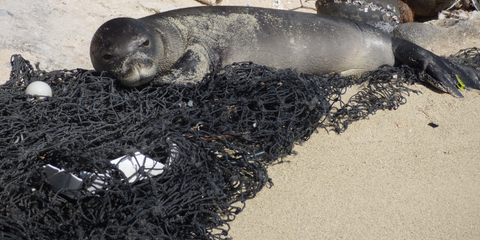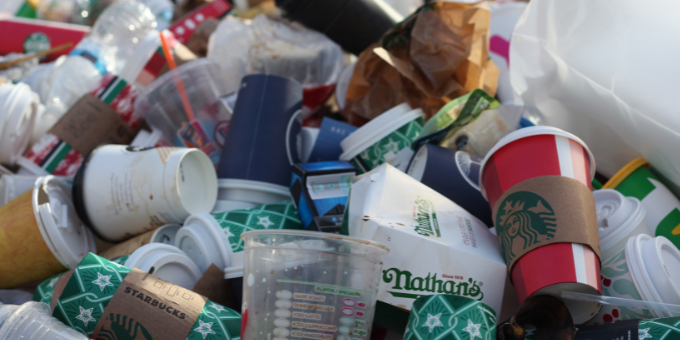Coffee cups have managed to slip under the radar in the war on single-use plastic. Find out why this is a problem.
Straws, cutlery and bottles have monopolised our attention, with new laws coming into effect in November that prohibit the supply of these items – and you probably remember the furore when plastic bags were ditched last month.
But paper coffee cups have escaped this single-use plastic action plan, even though, despite their name, these common utensils are brimming with plastic. Within the paper exterior, these cups have a plastic coating known as polyethylene, which serves the purpose of keeping the cup waterproof and heatproof, along with keeping its shape. Essentially, the function of a paper cup is rendered null and void without plastic.
Considering the global popularity of this drink – the International Coffee Association found we drink around 600 billion cups of the stuff each year – it’s no surprise that countless cups end up in landfill and in our oceans. To put a number to that image, Sustainability Victoria revealed that Aussies throw away 2.7 million coffee cups every year. That’s a lot of plastic.
Animals are some of the biggest victims of this pollution, with marine life copping the brunt of the 8 trillion tonnes of plastic invading our oceans every year, with a resulting 100, 000 deaths of marine life caused by consuming or getting entangled in these plastics – which then leads to suffocation and drowning. But marine animals aren’t the only ones in danger.

The health risks of plastic utensils.
Excessive use of plastic doesn’t just threaten our environment, but our health too. Simply eating or drinking something wrapped in plastic or held in a plastic container can cause us to ingest microplastics that had leached into our food and drink. Here’s where the problem begins.
Consuming microplastics can cause hormonal imbalances, endocrine and nervous system dysfunction, along with a range of inflammatory conditions. With research finding we consume 250 grams of plastic every year and, in our lifetime, we’re likely to consume over 20 kilos of plastic. In one week, we’re consuming the equivalent of a credit card. Appetising, right?
Well, it doesn’t end there – one category of plastics, known as phthalates, target the endocrine system, with studies showing that long-term exposure can lead to issues with fertility, reproductive function and child development. Scarier still, another studyfound the ingestion of microplastic fragments led to inflamed intestines , and these findings indicate that it can compromise the gut barrier and affect the gut microbiome.
Researchersstudying the impact of microplastic consumption on zebrafish found that it led to dysbiosis – this is the destabilisation of the microbiome, which can go on to contribute to the development of diseases like inflammatory bowel disease, irritable bowel syndrome and even type 2 diabetes.
So, it’s probably not a bad idea to give paper coffee cups the slip, especially when considering they are one of the most common sources of single-use plastic in the country. There are a few swaps we can make to keep these plastics out of the environment – and out of us too!

Alternatives to plastic coffee cups.
Reusable cups: You can find these at the supermarket, homeware stores and oftentimes on the counter at the coffee shop. They’re usually made of glass or stainless steel and can cost as little as $5. A one-off purchase means you’ll be set for years of use. Aussie company KeepCupwas started with the goal of reducing paper cup wastage and they produce their ecofriendly alternatives in a range of colours and sizes, including the standard barista sizes that your local café uses.
Drink your coffee at home:If you’re willing to sacrifice the perfectly steamed milk and stencilled leaf art that comes with the café territory, drinking your morning coffee at home can be an ecofriendly solution. It also doesn’t hurt that your wallet stands to benefit too – with a coffee on average costing $4, it can start to add up, and making your own is one way to slash costs.
Use a thermos: The thermos is the classis accompanist on camps and hiking trips, but they’re actually pretty convenient for everyday use too. It also provides better insulation to keep your coffee warm if you’re looking to sip it on the way to work. Whether you choose to bring your own home-made coffee or ask the café barista to pour your brew into your thermos, it makes for a great way to store hot drinks when you’re on the go. No more coffee stains on your shirt when the train suddenly stops!
Drink your coffee in store: If you’re not in a rush, next time that caffeine craving hits, opt for in store instead of takeaway. This eliminates the need for paper cups, plus considering many of us forget our keys on a daily basis, it’s not a stretch to assume we’ll probably forget our reusable cups on occasion too. For extra ambience and less waste, pull up a chair and take a moment to enjoy your coffee.

These are just some of the ways you can protect your health and the environment from the pervasive presence of plastic – without compromising on a good brew.






Leave a comment (all fields required)